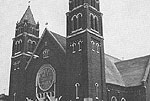
Grand Boulevard
— Washington Park (continued)
Chicago's relatively small black population of 44,000 in 1910
increased to nearly 250,000 by 1930. For years the outlines of
the city's "Black Belt" had been sharply defined: 31st
to 55th Streets along Federal and State. But new areas of black
settlement were emerging. Indeed, the line of march for the 1923
Elks parade illustrated how the old Black Belt boundaries were
being realigned. The parade began in the heart of the old black
district at 35th and Prairie, proceeded south along State Street
to 46th Street, then east to Grand Boulevard. Crowds of blacks
gathered along the parade route to cheer the 10,000 marchers,
and the Chicago Defender proudly noted that no parade had ever
before marched on Grand Boulevard.
As the black population of Grand Boulevard increased, 47th Street
between Indiana and St. Lawrence Avenues became the new black
shopping district. By 1927, 47th and Grand Boulevard was the
cultural and business hub of black Chicago, and the new Regal
Theater dominated
this intersection for the next forty-five years. Further proof
that Grand Boulevard was the bon ton black neighborhood
occurred in August 1929 with the opening of the Michigan Boulevard
Garden
Apartments (See Fig. 1). Philanthropist Julius Rosenwald
contributed nearly $3 million toward the construction of these
model apartments, which were all rented before the complex at
47th and Michigan was completed. The five-story walk-up known
as The Rosenwald remained one of the most prestigious addresses
in Grand Boulevard throughout the 1940s.
Whereas racial change in Grand Boulevard spanned a ten-year period
between 1920 and 1930, the Washington Park neighborhood experienced
a much swifter transformation from a white to a black community.
Despite the fact that Washington Park developed later than Grand
Boulevard, it did not remain a white stronghold. Although its
population was half the size of Grand Boulevard's, Washington
Park was composed mainly of apartment dwellers. Not only did thousands
of white families move out of the area as soon as their leases
expired, but many left even before blacks moved into their neighborhood.
In his famous trilogy Studs Lonigan, James T. Farrell
recreated the world of 58th Street, and he dramatized the response
of Irish
families to the expansion of the South Side Black Belt. Farrell
drew heavily upon his boyhood experiences in St. Anselm
parish, and he accurately portrayed
the confusion and fear of parishioners in the face of racial
change (See Figs. 2 and 3). While a number of families
in St. Anselm's moved to South Shore
in the early 1920s, others hoped the construction of a new Gothic
church on Michigan Avenue might keep the neighborhood white.
St.
Anselm's new church was dedicated in 1925, but within five years
nearly all the white parishioners had moved away.
«
previous
10
of 14
next
»
|
 |

|
 |


Figure
1: The Michigan Boulevard Garden Apartments, 54 E. 47th Street,
1951. »

Figure
2: St. Anselm Church, northeast corner 61st and Michigan,
1985. »

Figure
3: Interior, St. Anselm's, late 1930s. »
|